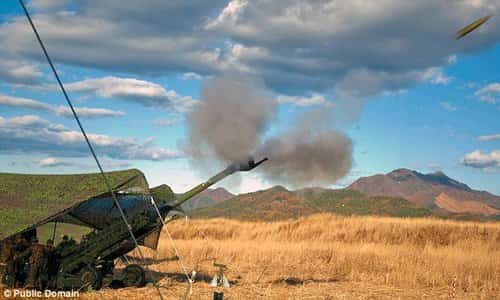City Killers - Electromagnetic Pulse Artillery Shells
 By PNW Staff February 02, 2017
Share this article:
By PNW Staff February 02, 2017
Share this article:
The US Army is developing a compact electromagnetic pulse weapon
(EMP) weapon capable of fitting inside a 155mm artillery shell capable
of being fired near key enemy infrastructure.
The
artillery shell, with its non-explosive payload, would be used to
disable the electronics and radio communications equipment of anything
within a given radius around its flight path.
Such
a weapon would disable the modern war-fighting capabilities of an enemy
but, aimed at an enemy town or city, it would act as a siege weapon
that would disable all communications and electronic infrastructure in
the vicinity.
Similar in concept to the
nuclear-based neutron bombs that the Soviet Union developed to kill
through intense radiation while leaving equipment unaffected, the EMP
rounds would disable sensitive equipment while leaving biological life
unharmed.
The line of research is outlined in an Army research document that describes the EMP artillery attack vector and its uses:
Extensive
use of wireless RF (radio frequency) networking for critical
infrastructure and communications systems provides an alternative attack
vector for neutralization of an adversary's underlying industrial,
civil, and communications infrastructure without the destruction of the
hardware associated with those systems.
Advances
in munitions-based microelectronics and power technologies make
possible the implementation of non-kinetic cyber and electromagnetic or
electronic warfare (EW) attacks that could be delivered via artillery
launched munitions.
The
precision delivery of the non-kinetic effects (NKE) electronics payload
close to the target allows low power operation which limits the
geographical extent of impacted systems and reduces the overall impact
on the electromagnetic spectrum.
The
eventual goal, as implied in the research proposal, is to shrink the
devices to the extent that multiple EMP bombs can fit inside a single
shell, but at this point the Army is still working to miniaturize and is
open to the possibility of employing larger bore guns if needed.
The
Army already possesses much larger directed EMP weapons, both ground
based and those mounted on drones that can disable all equipment they
overfly.
A reported 2012 test of a weaponized
drone dubbed CHAMP (Counter-electronics High-powered microwave Advanced
Missile Project) took out the electronics on seven targets it flew over
on a Utah test range.
Using directed EM
Pulses, the system uses ultra-powerful microwave generators to overload
the electronics found in military or civilian equipment.
Whether
this weapon would use traditional microwave generators as the drone
does or some other yet-unrevealed method to generate the sizable EMPs
needed is unclear, but the Army is researching several EMP-generation
systems.
Mounting the system on a truck or in a
downward facing orientation on a drone is relatively easy but any
ground-based vehicles require some degree of line-of-sight whereas a
drone can be shot down.
If the Army is
successful in miniaturizing the EMP bomb so that it fits into artillery
ordnance, it will be far more difficult for an enemy to stop its attack.
Nuclear weapons generate enormously powerful EMPs but the
accompanying heat, deadly radiation and kinetic energy makes them
impractical for tactical use on the battlefield.
The
Army's focus on medium powered EMP able precisely to target a specific
area with such an effective delivery system implies that the Pentagon
is concerned with collateral damage.
Frying
the electronics of a government ministry or weapons cache while keeping a
hospital and water treatment plant outside its range remains a
possibility.
In a world where battles are
fought with drones, advanced communications, smart munitions and highly
mobile troops, bringing your enemy back to the pre-digital age and
shutting down all communications equipment is an enormous tactical and
strategic advantage.
The concept has been
proven at larger sizes but now the challenge is set to shrink the system
into a package small enough to be fired in an artillery shell.
It
may only be a matter of time until we see even smaller applications
which present an ever-increasing danger to our digital societies.


No comments:
Post a Comment